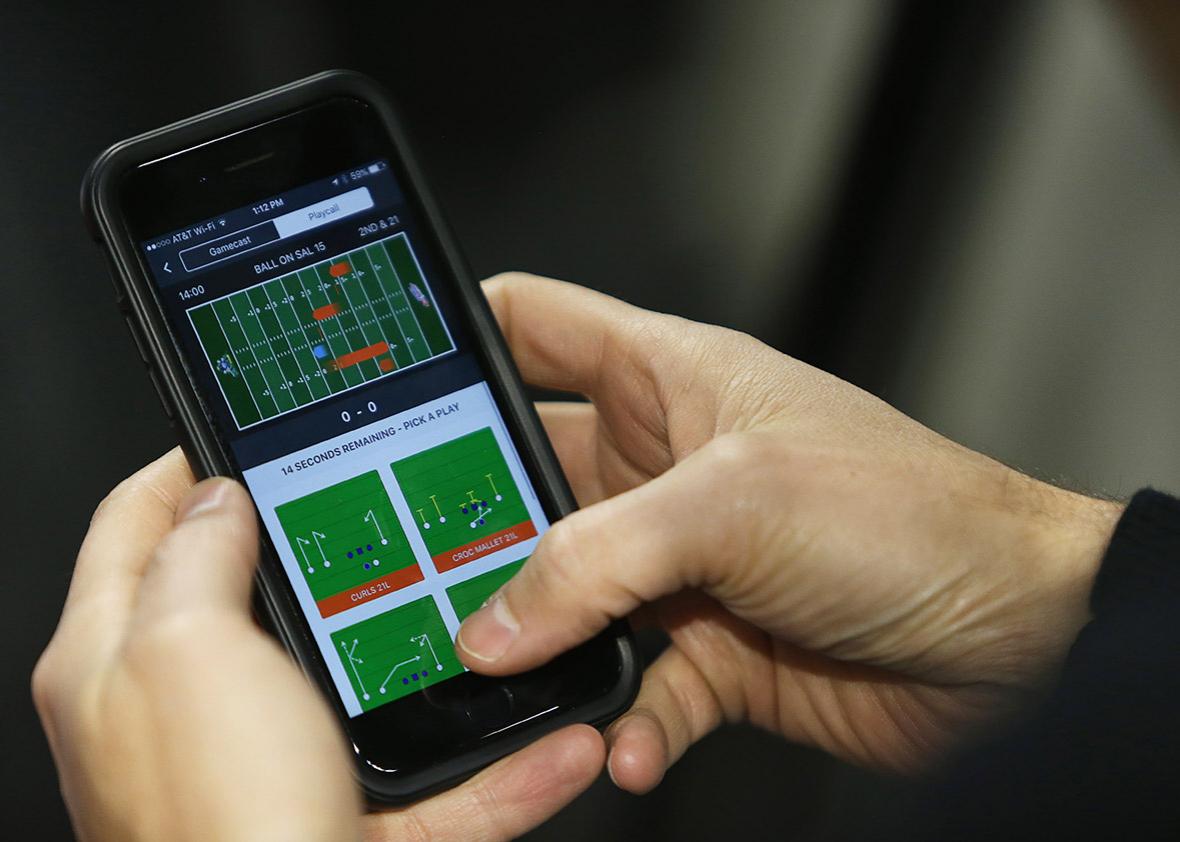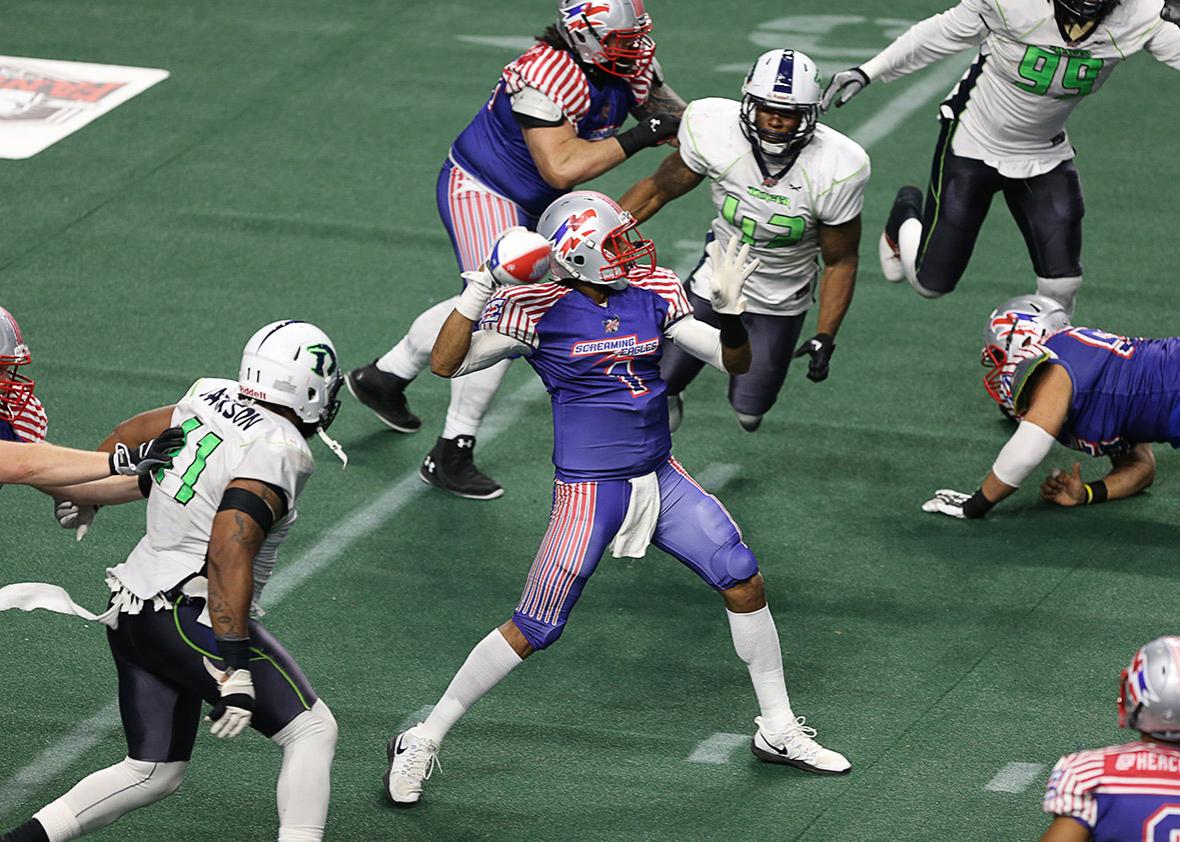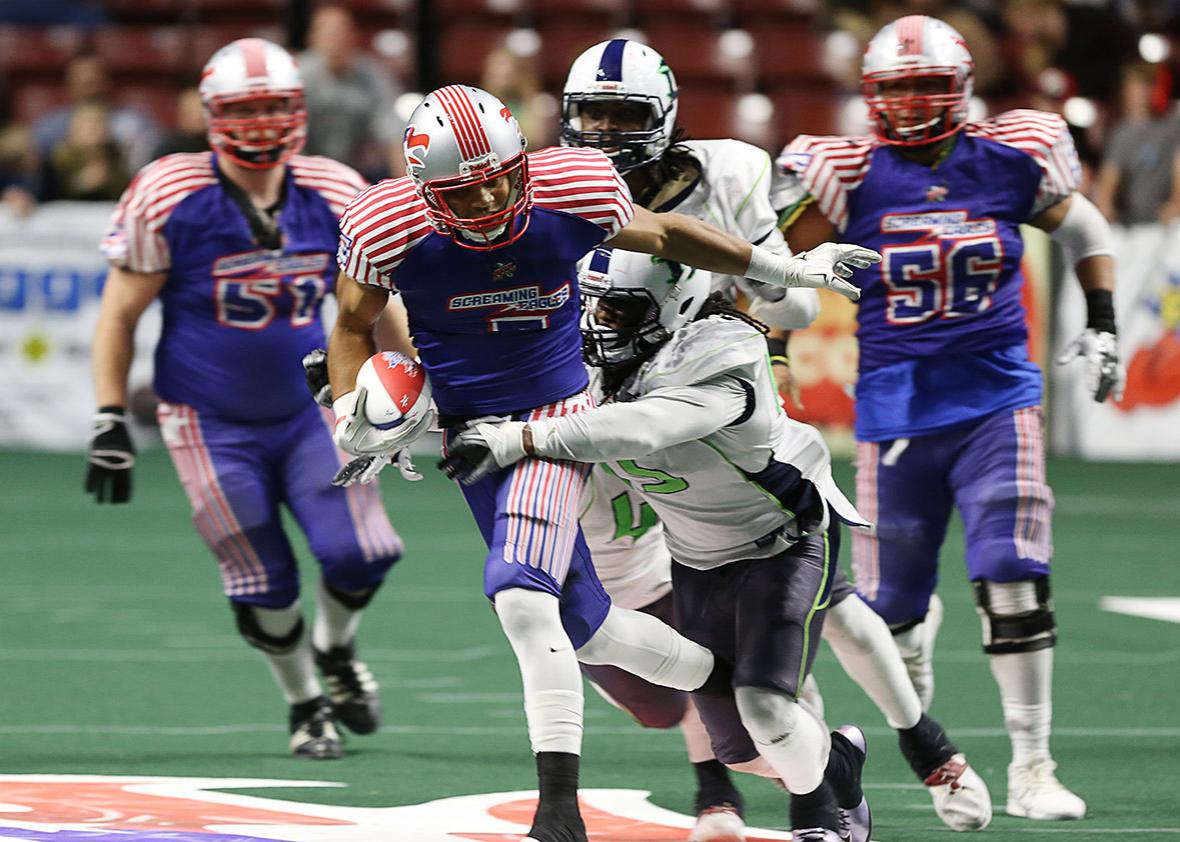In a drafty arena on the outskirts of Salt Lake City, near the end of a full-pads training camp practice for an expansion, eight-on-eight indoor football team, I think I may have witnessed the future of sports.
It wasn’t a 470-pound tight end with a 9-foot vertical and a 3.2 40, or a genius new spread formation that aligns the center behind the tailback. It was just a few dudes with an app and a dream who, if all goes to plan, could fuse the gap between live sports, massive multiplayer videogames, and fantasy geek analytics. They are the minds behind the Salt Lake Screaming Eagles—the newest franchise in the 10-team Indoor Football League, where tickets start at $5 and players make $250 a game—and they’re embarking on the first steps of a seasonlong experiment in what is being termed “interactive football.”
A couple weeks ago, a few rows up in the near-deserted stands of the Maverik Center—a minor-league hockey rink where the Screaming Eagles will play their home games—I watched a dozen or so nonathletic folks in jeans and parkas thumb their iPhones and Android devices. They’d been waiting for a scrimmage at the close of practice to run a live beta test, and now showtime had arrived. “OK, pick your play!” shouted a man in a hoodie sitting in the hockey penalty box, glancing at a laptop screen. Using the play-calling function on the Screaming Eagles mobile app, this test group—comprising team owners, employees, and a few pals—scrolled through diagrammed play selections, not unlike the kind you’d see while playing a Madden NFL video game. Each voted for his or her favorite run or pass.
Meanwhile, down on the sideline, the Screaming Eagles’ burly, bearded head coach stared at a separate laptop, impatiently awaiting the results. Once the leading vote-getter locked in (in this maiden effort, the winning play was a simple curl route), the coach barked the call to his quarterback as the 25-second play clock ticked. The QB broke the huddle, sprinted to the line of scrimmage, and—having been issued marching orders by the people in the seats—completed a curl to a receiver who was tackled for a short gain.
Not much to look at, footballwise. The players still seemed wary. But shouts and cheers exploded from the stands, with phones raised triumphantly in the air. Then noses immediately returned to screens. No time to gloat—the coach and QB were antsy, peering upward, waiting for the fans’ next call as the play clock ticked down again.
It didn’t take long before the Screaming Eagles offense had driven the length of the field—in the IFL, it’s just 50 yards from end zone to end zone—and punched the ball in for a touchdown. “I voted for that play!” laughed a hefty guy in a baseball hat. “That was my play!”
“You called that? Great call!” shouted one of the Screaming Eagles players, pointing up into the seats.
Sohrob Farudi, the team’s majority owner, looked on with a wide, almost disbelieving grin. “This is exactly what we wanted,” he marveled. “The players thanking the fans for calling their number! This is just how we dreamt it.”
* * *
Farudi is a 39-year-old Los Angeles entrepreneur who, back in 2011, sold a company called Flipswap that he’d built around a real-time pricing engine for used mobile phones. Although he didn’t clear enough to fulfill his childhood dream of buying the Cowboys, in 2014 he did become a minority owner of the Arena Football League’s Las Vegas Outlaws. “That was the worst experience of my life,” he says now. His six-figure investment resulted in a still-ongoing lawsuit and a bitter public feud with co-investor Vince Neil—better known as the bleach-tressed lead vocalist of hair-metal rockers Mötley Crüe. The Outlaws went kaput after a single season.
Farudi vowed to try football ownership again, but this time he had a far bolder idea in mind. He longed to wed sports with mobile technology to somehow create a team that was completely interactive—run entirely by its fans. He found a few other folks entranced by the idea, formed an ownership group, and went hunting for a team to mess with. They settled on the IFL, which had been formed in 2008, because it let them start with a blank slate by buying the right to launch an expansion franchise. And so, in October 2015, Farudi’s group plunked down the $75,000 fee. And the wackadoo experimentation began.
When Farudi said he wanted the franchise to be run entirely by its fans, he meant that he wanted the franchise to be run entirely by its fans. He started by putting the new team’s geographic location up for a vote. Both Oklahoma City and Salt Lake were viable options, he’d determined, so he put up a poll on the team’s website. Once Salt Lake won, he asked the public to bestow a nickname on the team. About 36,000 votes came in, with “Screaming Eagles” beating out options like “Teamy McTeamface” and “Spaghetti Monsters.” Farudi says he was actually disappointed in the conservatism of the online hordes. He was rooting for a more offbeat choice to win because it would garner easy publicity, plus offer early proof that he’d respect the fans’ wishes no matter how unconventional.
Farudi’s a bit unconventional himself. His main business ventures currently include a wholesale marijuana edibles startup and an outfit that sells specialty cooking charcoal to restaurants. He’s young and clever, bored by the thought of running a regular old team, and absolutely tickled by the notion of introducing something wholly new to the world of sports. Guided by his thirst for novelty, he kept pushing forward, searching for more things that fans could vote on.
Screaming Eagles partisans chose the head coach, based on a selection of résumés and some interviews the team uploaded to YouTube. Fans chose a portion of the players on the roster, based on college stats and footage from training camp practices. For a small fee, Farudi let folks dial into a weekly conference call, giving input directly to the team’s president as “virtual general managers.”
But his driving vision has always been to let the fans call plays. Farudi didn’t want this to be a one-time gimmick, like voting on whether to receive or defer on the coin flip or letting a local celebrity call pass or run on the first snap after kickoff. He was determined to allow regular fans to choose every offensive play, in every possession, all game long. He’d also try to give them final say on any other in-game decision that could feasibly be put to a vote. Boot the next kickoff deep or attempt to onside it? Kick the extra point or go for two? Everything was fair game.
Farudi was convinced he could make it work, technologywise. Certainly the fans in the arena could watch the game live and make quick play selections on their phones, choosing between a few tailored options. In the training camp session I watched, spectators got 15 seconds to lock in their picks, which left 10 seconds on the play clock for the offense to get to the line and hike. Sure enough, after initial hiccups, the team fell into a rhythm and had little problem executing the beamed-in calls.

Melissa Majchrzak
Streaming delays would prevent people watching a game online from voting in direct reaction to video footage. The fix for that was a quickie text readout within the mobile app—updating the current down-and-distance and time remaining—which would let fans vote without having to wait for the action to catch up on their live streams.
Until after the ball was snapped, only the Screaming Eagles coaches would be allowed to see the vote results. Otherwise an opponent’s defensive coordinator could simply look at his phone and know what play was coming. It’s true he could see which options were on the table for fans to vote on, but these would include enough variation to keep him guessing.
Perhaps the greater danger would be opposing fans hacking the process. What if they ganged up to click the Eagles into suboptimal play calls? What if they swamped the vote with demands to onside kick every time or go for a two-point conversion when a simple extra point would win the game? Farudi acknowledged there’d be no easy way to stop them. You can give the reins to the fans, but you can’t pick which fans take them.
* * *
The Eagles’ head coach, William McCarthy, won the gig with a 0.6 percentage point margin in the fan voting, mostly on the strength of a camera-ready, WWE-style personality that he unleashed in YouTube appearances. He’s a huge, bald, bearded guy, radiating toughness. Yet to watch McCarthy on the sideline is to observe a man who vacillates, moment to moment, between dictator and serf.
McCarthy’s coached for other IFL teams and various college squads, and when the team is on defense, he’s in his element. (Defensive play calls are not subject to the whims of Screaming Eagles rooters; there’s no time for fans to call defensive plays in reaction to the other team’s formation.) When his quarterback goes under center, though, he is suddenly, and very awkwardly, rendered powerless. He simply stares at a screen to see which play has been chosen, relays this info through his radio mic to the quarterback’s in-helmet earphone, and then prays that the wisdom of crowds applies to the gridiron.
The coach can tweak around the edges. For instance, were fans to call the same play three consecutive times, he might disguise it by varying the pre-snap motion of the receivers. In the final minute of the half or the game, he’s also permitted to seize control with a hurry-up offense that needn’t wait for fan input. And, before the game begins, McCarthy helps choose the fans’ menu of possible plays, in concert with the app designers and the team’s analytics chief (a former private equity analyst brought in by Farudi). Various down-and-distance situations each get buckets of plays, any of which McCarthy would theoretically be comfortable calling in that context. If he wants to make halftime adjustments after noting the other side’s weaknesses, he can ask the techies to ramp up how often fans will be offered the option of, say, a bubble screen
Still, compared with the tyrannical status enjoyed by most football head coaches, there’s a lot of passivity baked in to McCarthy’s role. And here one is tempted to muse on the risks of direct democracy and the perilous downsides of castrating expertise while empowering the unwashed masses. Because the single biggest impediment to a fan-run offense will almost certainly be the fans.
It’s a good bet that a fan collective will opt for a radically higher pass-run ratio than a professional football coach would. They’ll surely be more game to roll the dice on onside kicks and to go for two when the extra point would suffice. Sabotage by opposing fan bases could be entirely unnecessary—the Screaming Eagles fans might well sabotage themselves.
This could lead, in the end, to some interesting experiments in game theory, crowd psychology, and behavioral motivation. Suppose the team learns, through analysis of data from the first couple games, that fans are most likely to choose the play placed in the top right corner of the selection array? Would it start dropping the coach’s preferred choice in that precious on-screen real estate? If fans start voting for onside kicks all the time, the team could raise the threshold for a vote—requiring, say, 90 percent approval to attempt one. Should fans accept this? Would they rebel against these nudges? If they don’t, is the whole crux of the exercise diminished, ripping the power back out of the fans’ grip?
And what if you’re an opposing coach game planning for the Screaming Eagles? Will it be easy to analyze their tendencies, keeping spreadsheets of how fans have voted in given situations? Would you encourage your own fans to cross over and flood the ballot box?
This isn’t quite traditional sports, where coaches and athletes have autonomy. This isn’t e-sports, where gamers’ thumb dexterity determines their success inside a virtual world. This is, in essence, a melding of mind sports with live sports. From the app-wielding fan’s point of view, a Screaming Eagles football game is akin to a crowdsourced hand of poker or a committee playing one side of a chess match. The truth is, we’ve never really seen anything like this before, so we simply don’t know how it will turn out.
* * *
The Screaming Eagles’ ambitions shouldn’t obscure the reality that this is an arena-league football team, subject to the typical indignities that come with such an endeavor. The mascot wears an eagle costume copped secondhand for $2,500. The 66 yards of FieldTurf—$120,000 when bought by the now-defunct Richmond Raiders two years ago, then scooped up for $30,000 by Farudi when he needed to carpet the Maverik Center—is weirdly wrinkled in spots, bubbling up in an alarming manner. And then there’s the biggest buzzkill: For all your internet innovations, the fate of your franchise still depends on football players bashing into each other in meatspace.

Melissa Majchrzak
This turned out to be the Screaming Eagles’ downfall on Thursday night, when they took the field for their first-ever game. Players danced onto the field to DMX’s “Ruff Ryders’ Anthem”—chosen by the fans, natch. The players had their Twitter handles sewn on the backs of their jerseys, instead of their names, because INTERACTIVE. There was a hype man who whipped the crowd into a frenzy. But once the whistle blew, things went south.
The Eagles’ initial offensive series ended with a fumble in their own end zone, recovered by the Nebraska Danger for a touchdown. I was watching the YouTube stream of the game, and the chat box got real snarky, real fast.
“That wasn’t the play I called,” typed one wag.
“I don’t remember ‘drop the ball in the end zone’ as a play option in the app,” replied another.
Facing fourth-and-15 from the Eagles’ own 1-yard line on the team’s next possession, fans voted to attempt a 57-yard field goal. Due to its low trajectory it was easily blocked and returned for a second Danger touchdown.
There were fun moments. When the Eagles scored their inaugural touchdown, spectators were invited to storm the field and participate in the post-TD celebration. Why not? They called the play. (The resulting penalty didn’t help the overall cause.)
The game ended with a score of Danger 78, Screaming Eagles + Screaming Eagles Fans 47 Like the game itself, the app experience was less than perfect. It was hard to feel directly engaged—particularly voting from a couple thousand miles away—when each play looked equally chaotic and equally likely to end in a failed quarterback scramble. That was less the fault of the fans than of the Eagles’ offensive line. Even so, voting for each play became a bit tiresome after a couple quarters. Seeing in-app updates that read, rather abruptly, “Your play won—interception,” did not ramp up my enthusiasm.
But this was one game in a long season. And it was the tentative debut for a wide-ranging new theory about how to manage a franchise. The app will improve. The Eagles’ pass protection might, too.
If all of Farudi’s ambitious plans come to fruition, it’s easy to imagine an array of new opportunities. Instead of the tiny, regional fan bases endemic to most second-tier athletic leagues, an interactive team might lure in sports geeks from across the country, or even around the globe. What stats-obsessed, all-22-film-watching pigskin head wouldn’t be intrigued to play offensive coordinator, analyze practice tapes, and pick which players will start and which will sit? In chat rooms, he might sway other fans to help test his theory about surprise onside kicks in the first quarter, by convincing them to vote en masse for a sneak attack right after the second offensive series.
And oh, the monetization possibilities. A fan could conceivably make in-app purchases that would inflate the value of his votes. Or he might shell out a hefty sum to call one play all by his lonesome. (For now, fans can earn Screaming Eagles “Fan IQ” points by answering trivia questions and reading news items about the team. Those with the most points will eventually be given various perks, and maybe have greater stature in the play-call voting.)
Farudi and his partners—their Santa Monica, California–based company is called Project Fanchise—have already bought another IFL team, the Colorado Crush, and are planning to make it into a second fan-run team before the season’s end. Farudi thinks he can convince every IFL team to go fan-run next year, transforming the acronym to mean Interactive Football League. He envisions it as a sports-tech playground, with sensors in the balls and cameras on the helmets.
Whatever happens with the Screaming Eagles, or the fan-dominated IFL Farudi pines for, I do think the future of sports lies in here somewhere. The early mistakes will be corrected. Someone will surely figure this out.
My bet is that this sort of interactivity will soon come to minor league baseball. The sport has lots of long breaks in the action that would make voting easy. It’s also rife with crucial yet relatively noncomplex decisions like whether to pull a pitcher or to pinch-hit for a batter. Wouldn’t you want to vote on something like that?
For now, we’ll just have to gawk at the Screaming Eagles and their noble mission. A team of the fans, by the fans, for the fans. There’s hope for democracy, yet.
